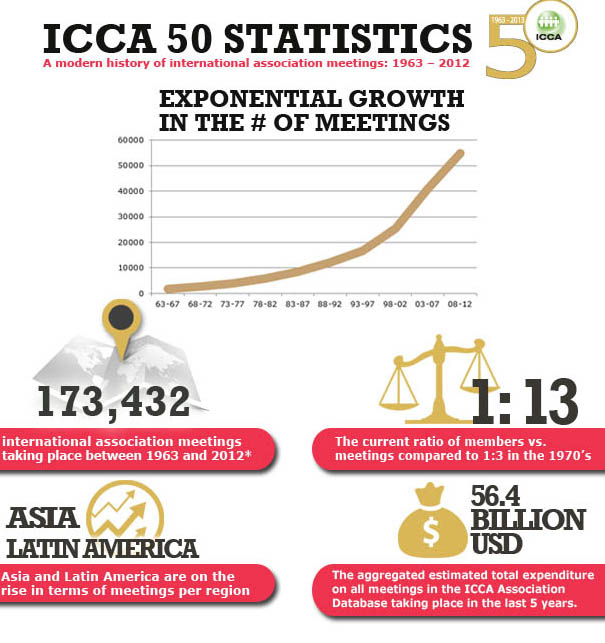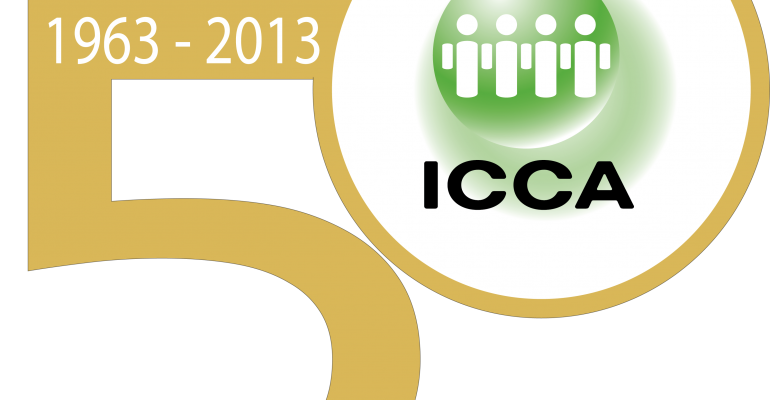A new publication from the International Congress & Convention Association traces the past half-century of international association meetings, emphasizing not their economic impact on host cities—which is significant—but rather their roles as drivers of societal change and of progress, particularly in the fields of science, healthcare, and technology.
Among the many statistics in “A Modern History of International Association Meetings” is the fact that some 2 million people participated in international association meetings between 1963 and 1968, while in the period between 2008 and 2012, that number grew to almost 22 million. Of course, while ever-more international congresses are held, and the total number of participants continues to expand, the impact of the on-site work extends far beyond those who attend in person.
ICCA’s report demonstrates this reach through case histories of meetings that have changed the world. The International AIDS Conference, for example, is the largest international meeting on HIV and AIDS, first taking place in Atlanta in 1985 and attracting 2,000 attendees. “For more than 25 years and in times of hope and frustration, the conference has played a central role in HIV, marking the evolution of the epidemic and serving as a platform for global discussion and presentation of scientific advances. The history of the HIV epidemic is interlinked to the International AIDS Conference,” ICCA’s report explains. The most recent conference—the 19th—was held last year in Washington, D.C., and drew 24,000 delegates from 183 countries.

Smaller, Shorter Meetings, But More of Them
ICCA’s research shows that international association meetings are more popular than ever—but they are changing. The average meeting has fewer participants and is shorter in duration. But when ICCA looks at the overall picture, these trends are dwarfed by an even larger one: The number of meetings held has been doubling every decade since the 1960s. Here are some of the stats:
• The average number of participants at international association meetings has dropped from 1,253 in the 1963–1967 period to 424 in the 2008–2012 period.
• The share of meetings with 50 to 149 participants has more than tripled, from 9 percent in 1963–1967 to 35 percent in 2008–2012, while the share of meetings with 150 to 249 particpants has grown from 13 percent to 22 percent over the same period.
• Correspondingly, the share of meetings with 500 to 999 attendees has fallen from 24 percent in 1963–1967 to 12 percent in 2008–2012, while the share of meetings with 1,000 to 1,999 attendees has shrunk from 14 percent to 5 percent over that period. Similar decreases are seen for all meetings of more than 2,000 attendees.
• The average length per meeting has dropped from 6.3 days in the 1963–1967 period to 3.8 days in the 2008–2012 period.
• Technological meetings show highest relative growth in the last 50 years: From 6 percent of all meetings in the first five years to 15 percent in the most recent five years.
• Medical sciences has always been the most popular subject matter, and remains so: 17 percent of all meetings in the past five years were about medical sciences.
• Science, which was the second most popular subject for the first four decades of the past 50 years, now drops to third.
Top Meeting City? It’s Been Paris for 50 Years
ICCA is well known for its annual rankings of the number of international association meetings hosted by cities and countries around the world, and Vienna has held the top spot for cities since 2005.
However, the new report reveals that Paris actually has hosted the most meetings in every five-year segment since 1963. ICCA explains this by commenting that Vienna’s meetings are reported right away to the database, while Paris meetings may be reported “two, three, or four years after they have taken place,” thus skewing the rankings.
Big risers in the ranks include three Asian cities—Singapore, Beijing, and Seoul—along with Barcelona, Berlin and Istanbul.
Considering world regions, Europe has consistently attracted the highest number of meetings over the past 50 years. However, its market share is shrinking—from 72 percent in 1963–1967 to 54 percent in 2008–2012. The Asia/Middle East region has seen a rise in relative popularity, with its share of meetings growing from 8 percent in 1963–1967 to 18 percent in the past five years. Latin America’s market share has grown from 4 percent to 10 percent in the same period, while North America dropped slightly from 13 percent of meetings in 1963–1967 to 12 percent in 2008–2012. (Among countries, the United States has consistently hosted the most meetings in every five-year period since 1963.)
The Next 50 Years
ICCA engaged Rohit Talwar, CEO of Fast Future Research, to look ahead at global trends and think about how those forces might change the face of the international association meeting. Talwar considered advances in four areas—biological/life sciences, information technology/Internet, manufacturing/robotics/new materials, and human enhancement.
In those areas he touches on many ideas, some of which seem impossible (human lifespans of 500 years), some merely hard to imagine (brain/computer interfaces that create “a vast and collective intelligence”), and others that seem rather likely (robots delivering lectures).
Ultimately, though, Talwar wraps up with a love letter to cities and to meetings. “Will it matter where we live if we can access everything instantly?” he writes. “We believe that geography will remain an important factor for many decades. Nations and cities will still seek to develop a lead in certain sectors and look to build clusters that bring together education, research, innovators, and financiers in order to deepen expertise and accelerate the transition from idea to market offering. With such a vast array of new industry sectors opening up, the prospects for vibrant, forward-thinking cities, regions, and countries to thrive should increase. Although we can conduct trade electronically, cultural and commercial factors will continue to drive the desire to meet, network, build trust, and do business.”




